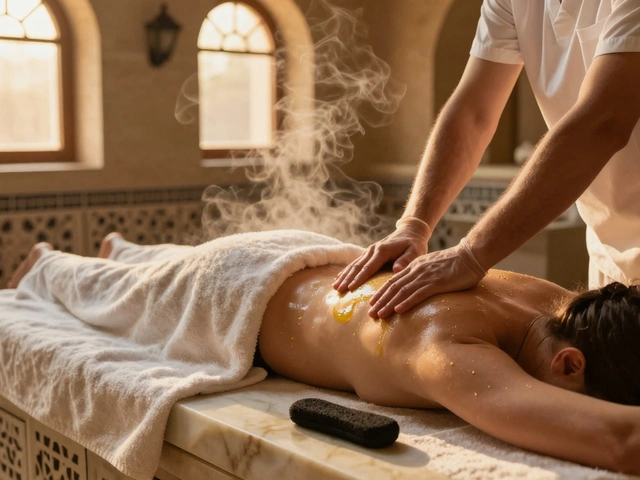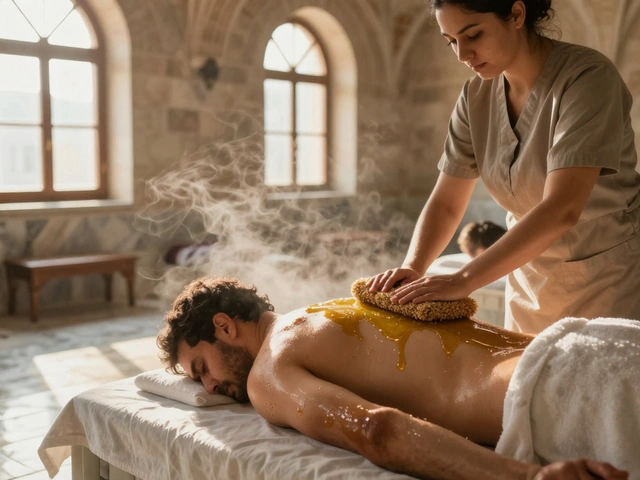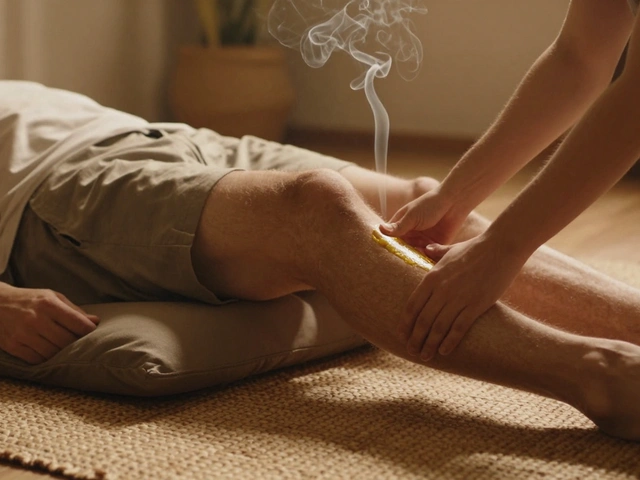If you’ve ever wondered why Istanbul is on so many “must-visit spa cities” lists, you’re about to find out. Istanbul’s massage scene is this wild mix where ancient hammam rituals and trendy wellness studios sit side by side. So if you’re feeling stressed or just want to see what all the buzz is about, there’s really something here for everyone.
Maybe you’re hunting for that old-school Turkish bath where clouds of steam and skillful hands work out every kink in your body. Or maybe you want a deep tissue massage with essential oils in a sleek, modern setting—you’ll find both without walking more than a few blocks. Even locals, like me and my husband James, argue over which is better: the classic silky touch of a hammam or the spa treatments popping up all over Beşiktaş and Kadıköy.
No matter which you pick, there’s one thing for sure—you’ll leave feeling lighter, calmer, and maybe even a little obsessed with Turkish tea after your session. Stick around as I dig into the best massage options in Istanbul, with tips on how to book, what it’ll cost, and how to make the most out of your experience.
- Key Points and Quick Takeaways
- What Makes Istanbul's Massage Scene Unique?
- Why You Should Try Massage in Istanbul
- Traditional vs Modern: Types of Massages Available
- Booking Tips, Pricing, and What to Expect
- Safety, FAQ, and How To Choose the Right Place
Key Points and Quick Takeaways
Istanbul stands out because it blends ancient hammam traditions with modern wellness trends, making it a unique city for massages. Whether you're after a full-on Turkish bath or a quick Swedish rubdown, this city has you covered.
- Best massage Istanbul experiences range from steamy, scrubby hammams to new-age spa treatments, so you can choose what fits your mood and needs.
- Most Turkish hammams have been operating for decades (some for centuries!)—you’re getting tradition and heritage with your relaxation.
- Modern spas in Istanbul often offer extras like aromatherapy or hot stone massages. There's a lot of choice, even within the same neighborhood.
- You don’t have to spend a fortune. Prices start around $25 for a basic hammam experience, but top-end hotel spas or specialty treatments will cost more.
- The most famous hammams are usually in the Old City (Sultanahmet) and tourist areas like Taksim, but you’ll find local gems in Asian side neighborhoods, too.
- Book your session in advance, especially at popular spots, to avoid long waits.
Here’s a quick look at massage options and prices in Istanbul:
| Massage Type | Typical Price Range (USD) | Session Length (Minutes) |
|---|---|---|
| Turkish Hammam | $25 - $60 | 30 - 60 |
| Swedish/Deep Tissue | $40 - $90 | 50 - 90 |
| Aromatherapy | $50 - $110 | 50 - 90 |
| Luxury Hotel Spa Package | $100 - $250+ | 90+ |
Quick tip: Not all spas accept walk-ins, and English might not be spoken everywhere. Booking through your hotel or using apps like Google Maps reviews can help you find good, reliable spots. Tipping is appreciated—5-10% is standard.
What Makes Istanbul's Massage Scene Unique?
One big reason Istanbul stands out is that it’s got centuries of experience—literally. The Turkish hammam tradition dates back over 500 years, and you’ll see places, like the famous Çemberlitaş Hammam or Cağaloğlu Hamam, still operating since the 1500s. These aren’t just relics; they’re thriving, and you can book a session just like the Ottoman sultans did.
But the city doesn’t stop at the past. Walk down any busy street, and you’ll spot day spas pushing the latest wellness trends. Think hot stone therapy, aromatherapy, and even sports massages used by Istanbul’s pro athletes. You’re basically choosing from the best of old and new.
Another thing: Istanbul is a total mixing bowl. You’ll meet locals and travelers in the same hammam steam room. The classic rituals usually combine a full cleanse, a foam massage, and plenty of heated marble—all in one session. Nowadays, some places toss in a modern menu, so you can book a foot reflexology or Swedish massage with your traditional bath.
Here’s something I didn’t expect—massage therapists here are highly qualified. To work legally, most have to pass government-approved training, so you rarely run into amateurs. Plus, a lot of spas have English and Russian-speaking staff to help out tourists.
- 500+ years: How long many of Istanbul’s top hammam locations have been open.
- 14 million people: That's the city's population, so the variety of massage places is wild—luxury spas, budget-friendly joints, even airport massage services.
- Neighborhoods to watch: Sultanahmet for the historic baths, Nişantaşı and Beşiktaş for stylish modern spas.
| Type | Typical Setting | Languages Offered |
|---|---|---|
| Traditional Hammam | Historic bathhouses | Turkish, English |
| Modern Spa | Hotels/Wellness centers | Turkish, English, Russian |
The city basically pulls together the best of both worlds to give you the best massage Istanbul experience, whether you're after tradition, innovation, or a little bit of both. Don’t be surprised if a one-hour visit turns into a full afternoon—folks here really know how to make you lose track of time.
Why You Should Try Massage in Istanbul
If you’re on the fence about getting a massage in Istanbul, you’re missing out. This city does relaxation in its own unforgettable way—where else can you go from a centuries-old hammam to a modern spa, both within walking distance? The whole vibe is built around slowing down, letting go, and getting a break from the city’s hustle.
The best massage Istanbul has to offer blends history with modern comfort. Traditional Turkish massages (like the famous hamam experience) have been a thing here since the days of the Ottoman Empire—so, we’re talking hundreds of years of practice. It’s not just about pampering. Turkish massages are believed to boost blood circulation, relax muscles, and clear out toxins. And trust me, locals don’t just do this for the tourists. You’ll see plenty of Istanbulites squeezing in a quick session after work, especially in busy areas like Şişli or Taksim.
Compared to regular spa days you might be used to, Istanbul massages often include touches like a full-body scrub (called the kese), foamy soap washes, and even steaming—think skincare plus muscle work all in one. Here’s what draws people in:
- Deep relaxation that actually feels long-lasting
- Cultural rituals you seriously can’t find anywhere else
- Expert therapists trained in both traditional and modern techniques
- Affordable prices compared to big city hotels or European spas
Worried about language barriers? Don’t be. Most masseuses in established hammams and spas know the basics in English, and some popular locations even offer menus in three or more languages. Plus, Istanbul’s tourist centers have staff used to helping travelers from all over; you’ll get by just fine.
| Massage Type | Average Price (2025) | Average Duration |
|---|---|---|
| Traditional Turkish Hammam | $40 - $70 | 45-70 mins |
| Modern Swedish/Deep Tissue | $50 - $90 | 60 mins |
| Aromatherapy Massage | $55 - $100 | 60 mins |
All this means you get a world-class experience without draining your wallet. Trying massage in Istanbul is like plugging into the city’s culture and coming out the other side recharged—shoulders dropped, brain un-frazzled. Seriously, if you try it once, you’ll wonder why you waited so long.

Traditional vs Modern: Types of Massages Available
Istanbul really nails it when it comes to massage options—think old-school ritual meets modern luxury. Let’s break down what you’ll find.
Best massage Istanbul offerings always start with the classic: the Turkish hammam. This is more than just a scrub; it’s a tradition going back centuries. You’ll get steamed, scrubbed down with a kese mitt, then rinsed and massaged right on a warmed marble slab. Most Turkish baths are serious about their 30- to 45-minute sessions, and no, you don’t have to bring anything—they’ll hand you a peştemal towel and slippers at the door. Hammams like Çemberlitaş and Kılıç Ali Paşa have been doing this since the Ottoman days, and you feel it the second you walk in.
Other traditional touches? You might see oil massages and cup massages (sometimes called „cupping“), which apparently were used by sultans for aches and pains. These are less about relaxation and more about working out stubborn tension or boosting your circulation.
Now, Istanbul’s modern spas are all about choice and luxury. You’ll see Swedish and deep tissue massages on the menu, designed for pure relaxation or pounding out muscle knots. Thai massage, with its stretching and pressure moves, is popping up in places like Nişantaşı and Levent. Aromatherapy is huge here too—massage therapists use lavender, eucalyptus, or rose oils for that extra kick of comfort. It feels less ritualistic and more like you’re on vacation, honestly.
If you’re curious about what each style focuses on, here’s a quick breakdown:
- Turkish Hammam: Steam, body scrub with kese, foam massage, rinsing. Great for detox and skin glow.
- Oil Massage: Slow, relaxing pressure using olive or essential oils. Nice if you want something gentle.
- Swedish Massage: Long, gliding strokes, kneading, circular movements. Best for unwinding.
- Deep Tissue Massage: Firm pressure on problem areas. Perfect for muscle aches.
- Thai Massage: Stretching, pressure, no oil. You wear comfy clothes and get moved around a lot!
- Aromatherapy Massage: Oils with scents for relaxation or energy, paired with a gentle touch.
- Cupping Massage: Special cups placed on your skin for a vacuum effect. Said to help with pain and stiffness.
Many spas let you mix and match, or add things like hot stones and foot massages. The bottom line? Whether you want ancient rituals or modern pampering, Istanbul’s got both, and it’s easy to try either—sometimes in the same building.
Booking Tips, Pricing, and What to Expect
Getting a quality best massage Istanbul experience is way easier than you think. First, most places now have easy-to-navigate websites with booking forms—most offer both English and Turkish, so you’re not stuck in translation limbo. Some even let you pick your therapist or type of massage on the spot. If you want the classic hammam vibe, spots like Çemberlitaş Hamamı or Cağaloğlu Hamamı accept walk-ins, but honestly, booking ahead is smart. Peak hours (think late afternoons, weekends, and tourist seasons) fill up fast.
When booking, here are a few tips to keep stress out of the process:
- Check user reviews on Google and local apps like Yemeksepeti's "Banabi" or TripAdvisor—people are brutally honest about good and bad places.
- Send a direct WhatsApp message to the spa. Most places in Istanbul actually reply way quicker there than by email.
- Watch for deals—some high-end spas offer weekday packages or combo deals if you go before noon.
Curious about what you'll pay? Here’s a quick snapshot of what prices look like as of June 2025 in some well-known districts. Most basic massages run from 800 to 2000 Turkish lira, but fancier aromatherapy or deep tissue treatments can cost more, especially at luxury hotels or in popular tourist spots.
| Massage Type | Location | Average Price (TRY) | Session Length |
|---|---|---|---|
| Classic Turkish Hammam | Sultanahmet/Old City | 900-1500 | 60-90 min |
| Deep Tissue | Beşiktaş/Sarıyer | 1200-2000 | 60 min |
| Aromatherapy | Karaköy/Galata | 1500-2200 | 60 min |
| Hot Stone | Luxury Hotels (Taksim/Nişantaşı) | 1800-3000 | 75-90 min |
What should you expect when you walk in? First, the staff will ask if you have any health issues. Most places provide slippers and disposable underwear—no need to lug flip-flops in your suitcase. If it’s your first hammam, get ready for lots of steam, a very thorough scrub, and maybe a soapy massage—don’t be shy, the attendants do this all day. Modern spas run more like places in Europe or the US: calming music, warm oil scents, fluffy towels, and usually a quick chat with your therapist about pressure and areas to focus on.
One last tip: Most city-center spas accept cards, but a few old-school hammams are cash-only—check this before you go so you’re not scrambling for an ATM in your bathrobe! And be on time: Turkish spas are famously punctual and may cut your session short if you’re late. If you can, arrive a few minutes early to wind down before your massage actually starts.
Safety, FAQ, and How To Choose the Right Place
Let’s talk safety, because getting the best massage Istanbul isn’t just about comfort—it’s about peace of mind too. Turkish spas and hammams have some of the highest hygiene standards in the world, but, just like everywhere else, it really depends on where you go. The top-rated places always use clean towels, sterilize equipment, and make sure staff are trained and licensed. You’ll see certificates and awards on display in most reputable locations. Don’t be afraid to ask how often things get cleaned, or if therapists have official massage training—most won’t bat an eye.
Worried about language barriers? Most places in central Istanbul, especially those popular with tourists, have English-speaking staff. If you end up somewhere more local, a quick Google Translate session or pointing to pictures on the menu goes a long way. Honestly, body language takes care of half the conversation anyway.
If you’re just starting your search and feel overwhelmed by the choices, here’s how to narrow it down:
- Read recent online reviews—look for places with high ratings over the past six months, not just one viral TikTok.
- Stick to well-known neighborhoods like Sultanahmet, Şişli, Beşiktaş, or Kadıköy where standards are higher for tourists and locals alike.
- Check out social media; top-notch spas usually post their certificates or happy customer photos on Instagram or Facebook.
- Look up their license—every legit massage place in Istanbul must display a health and business license.
Not sure what to wear? At hammams, you’ll get a traditional wrap (peştemal), while modern spas usually give you a robe and slippers. Swimwear isn’t required except at some hotel spas, so always double-check during booking. And if you have any health concerns—like heart issues, pregnancy, allergies—definitely flag that upfront, so the therapist can tailor the treatment.
Here’s a quick safety stat rundown, based on recent local health inspections:
| Type of Place | Passing Hygiene Rate (%) | Certified Therapists (%) |
|---|---|---|
| Traditional Hammam | 93 | 89 |
| Modern Spa | 97 | 94 |
| Smaller Local Parlor | 81 | 72 |
Still got questions? Here are some quick answers:
- Is tipping expected? Yes—10-15% is normal at most spas and hammams.
- Can I request a female or male therapist? Absolutely—just mention your preference when you book.
- Is it okay if I don’t speak Turkish? Totally fine, most massage spots in tourist areas have English-speaking staff.
- Are walk-ins possible? Sometimes, but weekends get busy. Booking ahead is your safest bet.
Bottom line: if it feels fishy, walk away. Trust your gut. Istanbul’s best massages are all about trust, relaxation, and clear communication—don’t settle for anything less.





